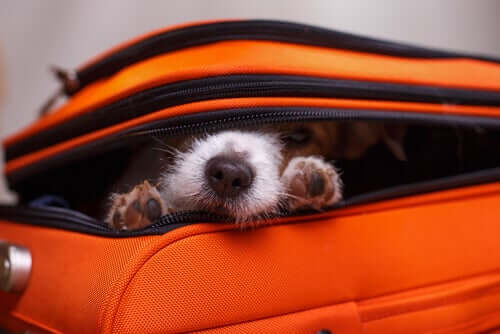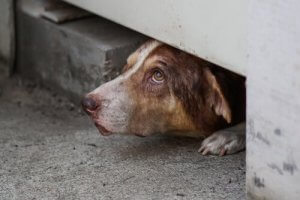Canine Behavior: Why Do Dogs Hide?

Dogs hide for a variety of different reasons, including anxiety and illness. For example, if a dog is in extreme pain, it may try to find a place to hide for a short while.
Dogs may also hide during periods of great anxiety, such as during a thunderstorm, or a loud party. They may feel safer if they’re hidden under a bed, for example, as it creates a sort of barrier between them and any source of noise or stress.
Some dogs hide out of fear
Some dogs will try to hide or flee when they feel scared. This could be because there’s a thunderstorm raging outside, or maybe there are lots of strangers in the house. This behavior is driven by the animal’s innate need to find a place where it feels safe.
You can use counter-conditioning or desensitization techniques to discourage this kind of behavior. These methods seek to help the dog overcome its fear, and become more comfortable in these sorts of stressful situations.
For example, if your pet hides during thunder and lightning, you could try playing quiet recordings of a thunderstorm while giving them plenty of treats, praise and cuddles. Then, slowly increase the volume until they no longer react to the noise.
Whether it’s caused by anxiety or illness, hiding can be a cause of concern to owners. If you’re worried about this behavior, don’t hesitate to take your dog to the vet.
Hiding as a result of pain or sickness
Dogs may also hide as a result of pain or illness. If you’re worried this might be the case, try to look out for other symptoms. For example, your pet may seem grumpier or more lethargic than usual, or have very little appetite.
If this behavior appears suddenly, it’s best to take your pet to the vet for a checkup. They’ll be able to run tests to determine if something is wrong, and treat any underlying medical conditions. Once your dog feels better, it probably won’t hide anymore.

Some dogs hide as a response to stress
There’s also the possibility that your dog simply needs a quiet, relaxing place to sleep. In the wild, wolves live in dens. If domestic dogs have retained this instinct, they may be trying to find a small hiding place that resembles a cave or den. In this case, it’s best to leave your pet in peace for a while.
It’s also possible that an animal suffering from stress may feel the need to disappear for a while in order to cope with their anxiety. Maybe they recently went through a traumatic experience, or there’s a new pet in the house.
It’s important to understand that there are many reasons a dog may feel anxious, whether it be a recent move to a new house, a death in the family, or a new arrival. Experts advise finding ways to help your pet cope with the stress and giving them time to adapt to the new situation.

Hiding toys
It’s also possible that your dog may simply be hiding its most treasured possessions, including its favorite toys or even your shoes.
Just like dogs like to bury bones in the yard for later, they may also hide objects in and around the house. Some dogs have a habit of storing their things in places they consider safe.
Is it possible to discourage this behavior?
If this behavior is caused by anxiety, experts advise establishing a set daily routine. This means feeding, walking and playing with your dog at specific times. By keeping to this schedule, you give them a sense of stability which can help relieve their anxiety.
It’s also a good idea to give your dog a safe, quiet space to escape to in times of stress. Having a quiet room your dog can go to whenever it needs to can help relieve stress.
Finally, never force your dog to socialize with new people or unfamiliar animals. Give your pet some space, and allow it to come out in its own time.
All cited sources were thoroughly reviewed by our team to ensure their quality, reliability, currency, and validity. The bibliography of this article was considered reliable and of academic or scientific accuracy.
- Döring, D., Roscher, A., Scheipl, F., Küchenhoff, H., & Erhard, M. H. (2009). Fear-related behaviour of dogs in veterinary practice. The Veterinary Journal, 182(1), 38-43.
- Walker, R., Fisher, J., & Neville, P. (1997). The treatment of phobias in the dog. Applied Animal Behaviour Science, 52(3-4), 275-289.
